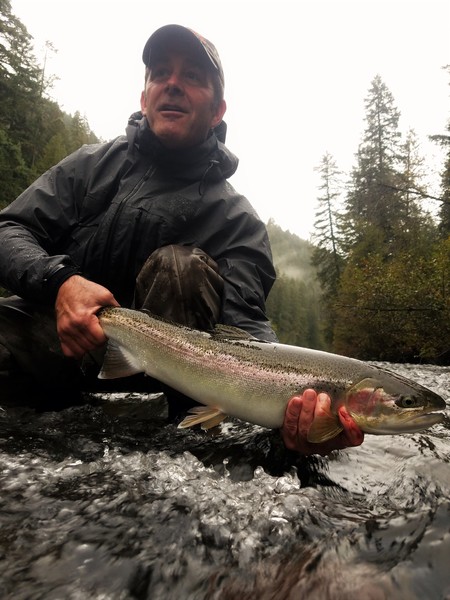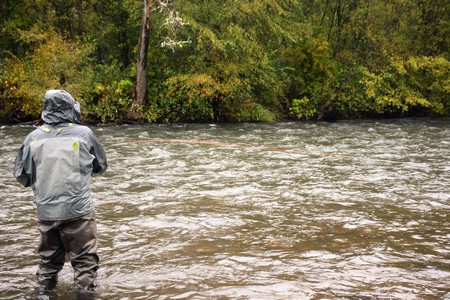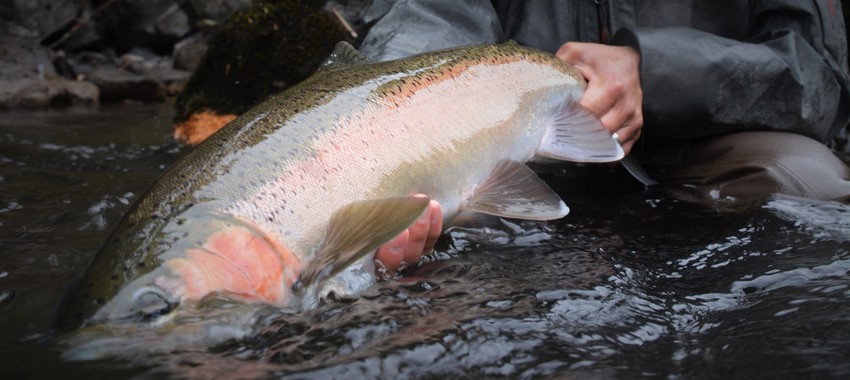Time to SLOW Down Guys - Tips for Adverse Conditions
October 11, 2016
Last week I was reminded how important it is to ease up a bit and slow yourself down. True with pretty much everything in life, but fly fishing in adverse conditions is something that you usually can't just power through with shear effort. There are critical decisions to make in every fishing day, and taking some time to process and reflect on your strategy and decision making is essential. As a guide you feel a lot of pressure to manage the trip as best you can. Sometimes this means pushing hard, long floats, big flies, covering water, and going on the offensive to win games. This can work in many situations and has been my typical mode of operations for many years. It can also bite you right in the ass haha! I have been on both sides of this equation many times. If you aren't sure... slow down.
What Are Adverse Conditions?
This is a rough list, just want to keep you paying attention when you are out there on the water as to what might stiffle fish activity. At times, these events will trigger feeding but you should still slow down and try to figure out how to maximize your efforts.
- Sudden weather changes
- Rising water (summer and fall rains can be very good).
- Snow melt - Usually bad. This water comes in icy cold and often thwarts the bite.
- Dirty water (if the trend has gone from clear to dirty)
- Water above 65 degrees
- A sudden cold snap
- Water below 40 degrees
- Icebergs. Seriously. I've been there.
Especially in the fall as things cool down and slow down. Here is a shot of a fish we got last week during a rainstorm. The river was coming up, we pulled back on the reins and caught it a little slot that you couldn't have fished without getting out of the boat and fishing it on foot. So many anglers float past this spot. In normal conditions I don't believe that little spot holds fish, but in a rising river they will take refuge there.

I will continue this rant from the perspective of a guide, and you should be able to relate as a DIY angler because in fact... you are your own guide! Being a guide is essentially like being the offensive coordinator of an NFL team. Its up to you to manage the clock and the ball in a way that will give you a win. Some games will be high scoring and its your job to move the ball fast. Even if you turn the ball over 4-5 times a high powered offense can still win right? Well, not every day will you be able to have 600 yards of offense from the line of scrimmage. Often... its a bit of a grind. Punt the ball when you need to, don't fumble on your end of the field, and just persistently run your offense and wait for a break. These are how you win the tough ones.
Fishing days are exactly like this. If conditions are good you can cover a lot of ground, run a fly over the enticing spots once, and the fish will comply. Lots of fish thanks to covering lots of water fast. Inversely, there are days when the river is muddy or the bite is off. These days are common! These are the days when you need slow down, think things through, and deductively. Since fishing days are measured in time, not river mileage, how you manage the clock is key.
On Friday this last week I was on the Klickitat River, it actually doesn't matter what river, because its strategy logic that matters. We got started in the morning and the river had decent clarity with just hint of green. Probably 4' of visibility, in fact it was so clear I stood on some high banks trying to spot steelhead to sight cast at! By 10 am it started getting dirty, by 1 pm it was like coffee and half 'n half. As the day wore on we had to shift gears from what we thought would be a high scoring game turned into a grudge match. As the water got dirty we slowed everything down. Our game had to change. We actually started to throw less casts, in better spots, and do the small things to try and generate success. We skipped all the marginal water. My mindset changed over the years. You can tell because I have started getting grey hair. Those two things must be related. In off colored water I tend to hyperfocus on a few spots and make what I know to be perfect drifts in the most likely areas. I will take the time to change flies, change depth, and especially slow down and fish it from the inside out. Now this advice might sound obvious.... but I SEE PEOPLE DO OTHERWISE EVERY DAY! They drift too far, hurry too much, etc. They fish on the move and don't "re-fish" their favorite water.
Yesterday I was on the Klickitat River and fortunately had all but two spey runs to myself. There was a guy named Steve Joyce, you may have heard of him, that poached my #1 go to spot and as I floated around the corner to find him in there wasn't bad enough but they had the damn net out with a bent spey rod! It was pretty funny timing. Anyway, after throwing a few rocks at him, kidding, we cruised downstream. That really put a wrench in my spokes. It was like losing my star running back in the 4th quarter. At that moment I had my only strategy shortfall of the day. I had gotten all my favorite runs in the morning, but mid-day I lost 2 of my best, and was down quite a ways in my float with nothing but mediocre spey water remaining. At that point the river was rising, and I really wished that I had "re-run" a couple of my favorite holes from earlier with different flies or heavier sink tips. Regarding steelhead, if the river is rising or dropping fast the fish are likely on the move and it isn't a bad idea to stay put in your favorite water, so long as nobody else is waiting for a turn. We swung two mediocre zones that were fresh, instead of a "re-run" through one of my favorites that was stale. In rainy conditions I will always take a re-run on the best spots rather than a fresh pass on the mediocre stuff. Just my opinion. I didn't like that trade off, but in the 2nd to last spot we wound up hooking a super hot steelhead! Here is Bob shortly after hookup. Notice the low rod angle.... and the Alder leaves pasted to his back! It was rough weather yesterday.

It was an incredible take and fight. The fish hit it at full speed on a fly mid water column in fast water, its what every angler dreams about. Hitting that fish was awesome, but all afternoon I was regretting not slowing down and giving those first couple runs a 2nd pass. The great Ed Ward once told me, "its better to fish a run twice fast rather than once slow". I have always remember that and quote him all the time but I feel like we should have taken that to heart yesterday. Other than that it was a good day, just very rainy.
Summary of Tips for Adverse Conditions
- slow down
- Slow Down
- SLOW DOWN
- Spend time in the water you are most confident.
- Less is more. Don't beat the best water to depth. Take a cast, wait a moment. Take a cast, wait two moments, etc. All it takes is one cast so why the hell do we all throw so many?
- Vary your indicator depth.
- Fish inside corners (if on a river).
- Fish isolated slots.
- DO NOT FISH BOILING WATER on a rising river. If the water doesn't have a gentle horizontal flow to it, move on. Trout like horizontal flow not mushroom currents.
- Take it easy, think about your casts. This is for real. When I am having a tough day I am very sensitive as we approach my favorite water. Often I only let one client fish at a a time. Its about one fish first, the second fish comes second. I am willing to take less casts but spend them more wisely.
- Don't snag bottom. If you are snagging a lot... don't. Just don't. I won't even bother explaining why. I'll just say its noisy and waste of energy. Figure out how to catch fish without snagging more than a few times a day.
-
Wow! Thanks for the great tips, Joe!
![Reds Fly Shop [logo]](/img/reds-fly-shop/logo.png)
